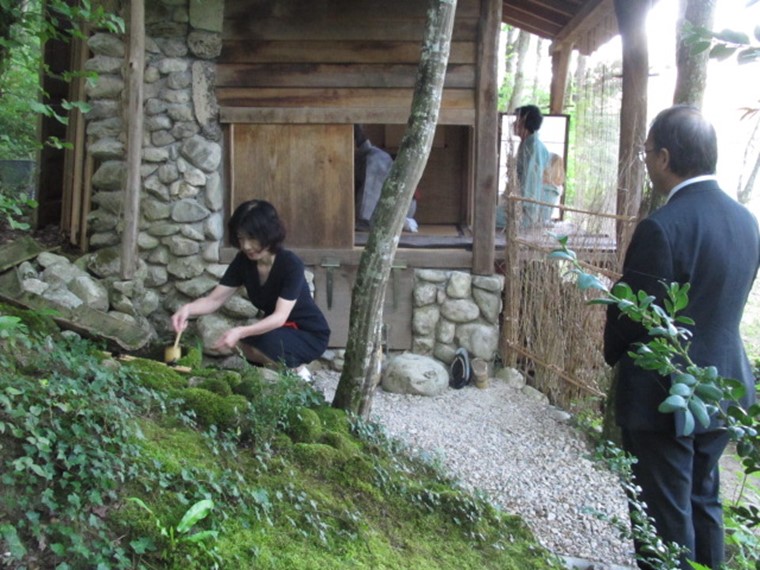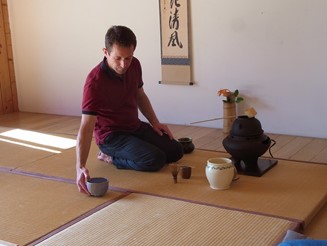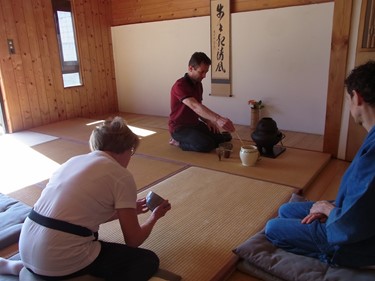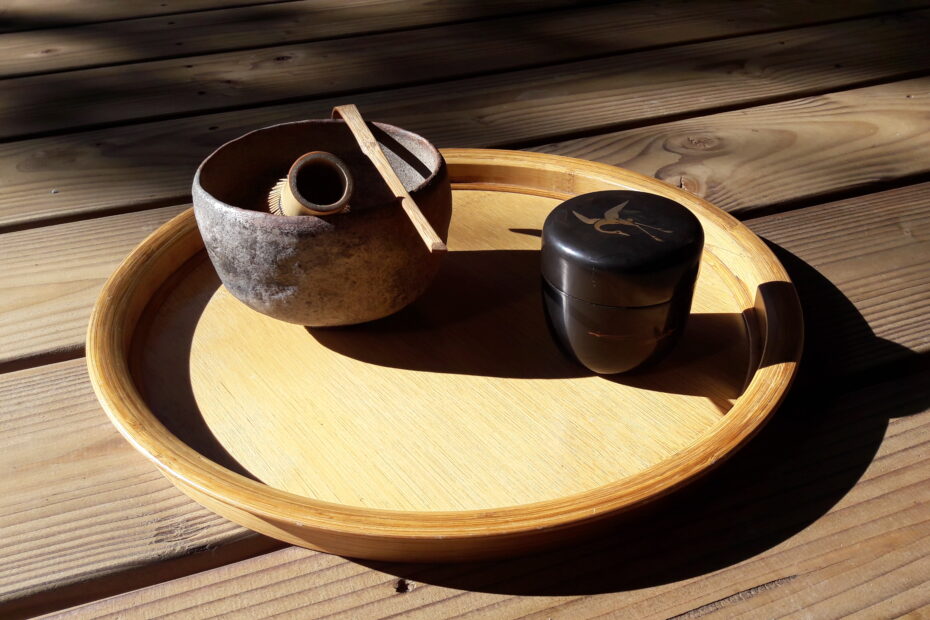Washing your hands

In the tea room, you may touch precious and fragile objects—silks, for example. Before entering the room, it’s therefore essential to make sure you have perfectly clean hands. There may be a tsukubai, a stone basin, at the entrance of the tea room for purifying your hands. If you’re unsure, rinse your hands before going to the tea room and take a clean tissue so you can wipe your hands if needed.
Entering the tea room
It’s best to have three essential instruments with you: a fan, used for greetings; kaishi, special paper on which a small cake is served; a kuromoji, sweet-pick used to cut and savour fresh cakes. If the host serves traditional sweets there is no need for a kuromoji.
After opening the door, I offer a gassho bow just as when I enter a zendō or a dojo. If possible I sit in the seiza position, I place the closed fan in front of me and I bow, placing both hands down on the floor.
- I get up and I enter the room, left foot first.
- I go and look at the tokonoma—the area where there is calligraphy and/or a bouquet of flowers—then the practice area where the kettle is set up. I step onto the tatami over it’s short end; I never step across the edge that separates it from the rest of the room.
- After making these observations, I go and sit down.
Each guest does this in turn. The first person to enter the area is the first guest. After making their observations, the first guest takes their place near tokonoma. The second guest sits to the left of the first guest, and so on.
Welcome
When the host enters the room, everyone bows. This is the moment to exchange verbal greetings and make informal comments on the season, the flowers that we admired when arriving, etc.—and on the calligraphy, of course. The host places the tray of small cakes in front of the first guest, who thanks the host by bowing. The guest then places the tray near their right knee, outside the edge of the tatami on which they are seated.
Preparing the bowl
The host enters with the bowl. Everyone bows. The host sits in front of the kettle and organises the objects. Before starting the practice, everyone bows once again.
Each person, host and guests, adjusts their seated position so they can remain comfortable without having to move. Just like for zazen!
The practice starts in silence.
Unless the host gives indications, we serve ourselves a small cake when the host puts the tea in the bowl. To do this, I take the tray and place it between myself and the guest to my left—always outside my tatami. We bow, I say: “osaki ni”—I precede you. I take the tray again and place it in front of me. I bow to the host, quietly saying: “itadakimasu”—I receive this. Only at that moment do I bring out a kaishi—the paper on which to put the cake—and I serve myself. Then I place the tray between myself and the next guest. I eat the small cake, fold the kaishi and put it to the side. The other guests serve themselves in the same way and eat their small cake. The last guest places the tray to their left so as not to be hindered when they go to get their bowl.

Going to get the bowl
When the bowl of tea is ready and the host has placed it on the outside of their tatami, I get up to go and get it. I sit in the seiza position, I take the bowl in my right hand and place it in my left hand. When I do this, I’m simply present in my movements. I don’t try to thank the host. In Zen, we do one thing at a time and we do it wholly! Getting up and moving is already a lot!!!
When I’m back in my place, I sit down and place the bowl in front of me outside the edge of the tatami on which I’m seated.
Drinking the tea
- I adjusts my seated position to be comfortable.
- I take the bowl, which I place inside the edge of my tatami, between myself and the guest to my right—of course I don’t do this if I’m the first guest. We bow and I say: “oshōban itashimasu”—I drink with you.
- I take the bowl, which I place between myself and the guest to my left. We bow and I say: “osaki ni”—I drink before you. Of course, I don’t do this if I’m the last guest.
- I take the bowl and I place it in front of me, still inside the edge of my tatami. I greet—at last!!!—my host and I thank them for the tea: “itadakimasu” or better still, “otemae chōdai itashimasu”.
- I take the bowl, I raise it to the level of my face to thank the universe for giving me this drink.
- I slightly turn the bowl twice—two eighths of a turn—in a clockwise direction to bring the front facing towards the left. I drink—at last!!!—taking three or four sips.
- I delicately drain the last drops to be able to observe the bowl and turn it over without spilling tea on the floor. It is customary to make a slight noise when inhaling.
- With my right thumb/index finger, I wipe the edge of the bowl to remove any residual liquid. I wipe my hands on the kaishi which I previously folded and placed to my right—avoid getting sugar on your hands or on the tatami.
- I turn the front of the bowl towards myself and put it on the tatami.
- I observe the bowl: I look at its overall shame and I turn it over, without lifting the bowl more than 20 cm from the floor—I may have a highly precious object in my hands. Even if this isn’t the case, this attitude shows that I am vigilant and attentive, that I’m not compulsive in examining the object. It’s best to keep one’s elbows on one’s thighs as this automatically limits the height one can lift the bowl. This is the moment to ask the host questions about the bowl, the tea, the small cakes, etc. During this stage, it’s desirable to exchange verbally.

Return the bowl
I get up. The front of the bowl is facing me. I move as if to pick it up and I place it exactly where I took it, taking care to turn the front towards the host. I turn the bowl in an anti-clockwise direction. I return to a sitting position.
End of the practice
The role of the host is to prepare the bowls of tea. If we don’t tell the host to stop, they continue…
If I’m the first guest, it’s up to me to stop the host. I check with the other guests that no one wants another bowl of tea—a look is enough. Since the start of the practice, I noted that the host rinsed the bowl between each preparation and then wiped it dry. I therefore leave the host to rinse the bowl but before they dry it I indicate that they can stop: “dōzo oshimai kudasaimase”.
The host cleans and arranges the objects. The host bows when leaving. One after the other, the guests get up, go and bow to the tokonoma one last time and leave the tea room.
Some important notes
- Remain silent while the host prepares the tea. It’s an opportunity to meditate together. Only when we drink do we initiate conversation.
- When we handle a bowl, each hand has a different function. We take the bowl with the right hand and we put the bowl down with the left hand.
- The host may have an assistant who brings us the bowl. The process of drinking the tea remains the same. After drinking, we place the bowl where it was brought to us, turning the front to the exterior, that is, towards the person who will come and take it.
- You can say the formal expressions in your own language, of course. Forcing yourself to remember the Japanese words adds unnecessary tension for beginners.
A piece of advice
Don’t worry if you have never experienced a tea ceremony before. It is important that the first experience is devoid of constraints.
If you have already experienced a tea ceremony, read this text with a highlighter or take notes to focus on the points that feel important to you. Don’t be too ambitious; start by focusing on how to drink the tea.
Persevere!!! It’s through experiencing the ceremony over time that you will explore fluidity and experience harmony.
The French version of this article was written by Franck Armand and is published in the Falaise Verte Zen Centre Newsletter number 73.
